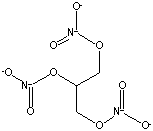Nitroglycerin, solution in alcohol, with more than 1% but not more than 5% Nitroglycerin
- 1,2,3-Propanetriol, trinitrate
- Nitroglycerol
- Nitrocardin
- Glyceryl trinitrate
- Glycerin trinitrate

Nitroglycerin, solution in alcohol, with more than 1% but not more than 5% Nitroglycerin | |
| |
| Formula | C3H5N3O9 |
| Structure |  |
| Uses | Explosive. Medication |
| Registry Numbers and Inventories. | |
| CAS | 55-63-0 |
| EC (EINECS/ELINCS) | 200-240-8 |
| EC Index Number | 603-034-00-X |
| EC Class | Explosive; Very toxic; Danger of cumulative effects; Dangerous for the Environment |
| RTECS | QX2100000 |
| RTECS class | Tumorigen; Drug; Mutagen; Reproductive Effector; Human Data; Primary Irritant |
| UN (DOT) | 3343 |
| Merck | 12,8913 |
| Beilstein/Gmelin | 1802063 |
| Beilstein Reference | 4-01-00-04351 |
| RCRA | P081 |
| Canada DSL/NDSL | DSL |
| US TSCA | Listed |
| Austrailia AICS | Listed |
| New Zealand | Listed |
| Japan ENCS (MITI) | Listed |
| Korea ECL | Listed |
| Properties. | |
| Formula | C3H5N3O9 |
| Melting point, °C | 144 - 146 |
| Solubility in water | Insoluble |
| Hazards and Protection. | |
| Storage | Keep in a cool, dry, dark location in a tightly sealed container or cylinder. Keep away from incompatible materials, ignition sources and untrained individuals. Secure and label area. Protect containers/cylinders from physical damage. |
| Handling | All chemicals should be considered hazardous. Avoid direct physical contact. Use appropriate, approved safety equipment. Untrained individuals should not handle this chemical or its container. Handling should occur in a chemical fume hood. |
| Protection | Wear appropriate protective gloves, clothing and goggles. |
| Respirators | Wear positive pressure self-contained breathing apparatus (SCBA). |
| Small spills/leaks | Make no contact with the spilled material. ELIMINATE ignition sources and ground all equipment. Flush area with flooding quantities of water. |
| Stability | No data. |
| Fire. | ||||
| Fire fighting | Use plenty of water - FLOOD it! If water is not available, use carbon dioxide,dry chemical or dirt. | |||
| Hazards | DRIED OUT material may explode if exposed to heat, flame, friction orshock; Treat as an explosive. | |||
| Combustion products | Fire may produce irritating, corrosive and/or toxic gases. | |||
| NFPA | Health | 2 | ||
| Flammability | 3 | |||
| Reactivity | 4 | |||
| Health. | |
| Exposure effects | |
| Ingestion | See inhalation. |
| Inhalation | May be toxic if inhaled, igestioned or on contact.. |
| Skin | Can be absorbed through the skin. May cause burns. See inhalation. |
| Eyes | May cause burns. See inhalation. |
First aid | |
| Ingestion | Treat ingestions of greater than 40 milligrams per kilogram with decontamination of the stomach if within 4 hours of ingestion. Administer charcoal as a slurry. |
| Inhalation | Move victim to fresh air. Apply artificial respiration if victim is not breathing. Administer oxygen if breathing is difficult. |
| Skin | Remove and isolate contaminated clothing and shoes. Flush with running water for at least 20 minutes. |
| Eyes | Flush with running water for at least 20 minutes. |
| Transport. | ||
| UN number | 3343 |  |
| Response guide | 113 | |
| Hazard class | 3 | |
| USCG CHRIS Code | NTG | |
| Std. Transport # | 4910310 | |